|
Author
|
Topic: Manchester brochure, 1955
|
taloncrest
Posts: 169
Registered: Jun 2004
|
 posted 01-23-2010 04:58 PM
posted 01-23-2010 04:58 PM
  
Here's a Manchester brochure from 1955. I split the price list into separate photos and I left off the panel dealing with silver care. I left the illustrated reverse side together except for the title panel. 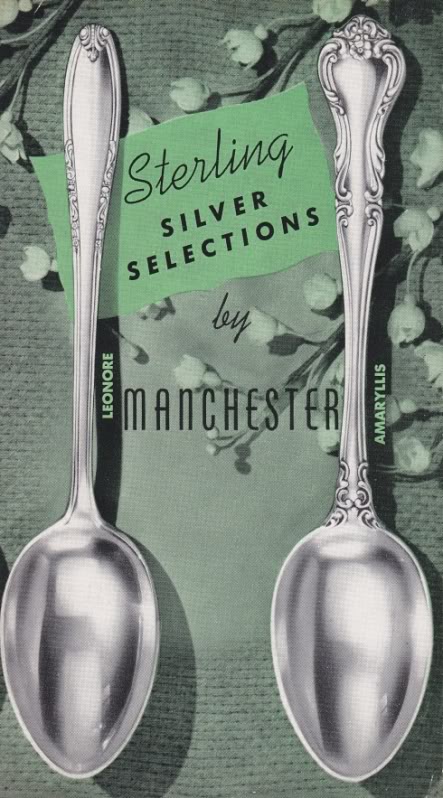
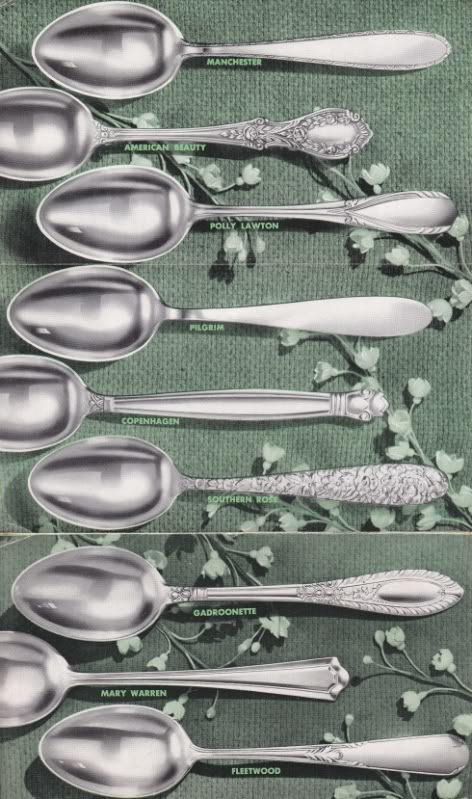
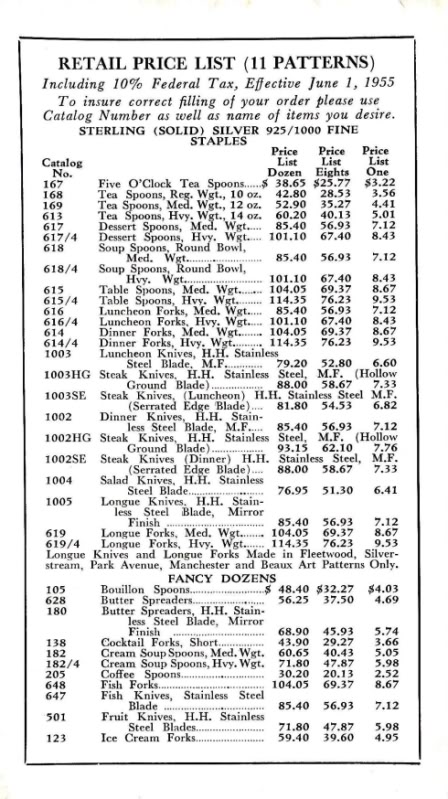
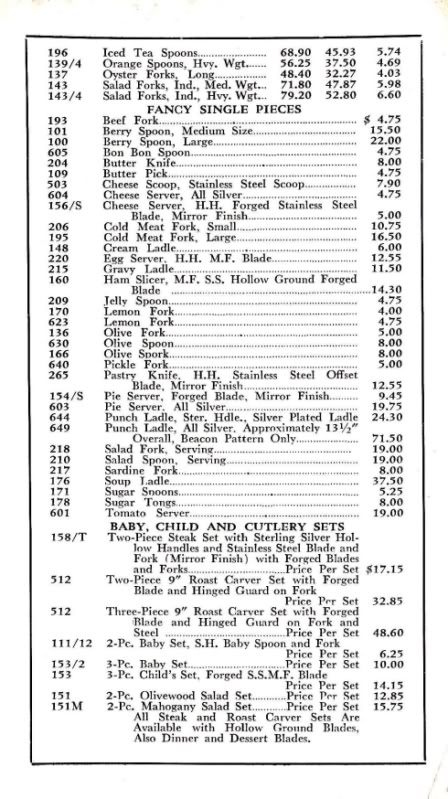
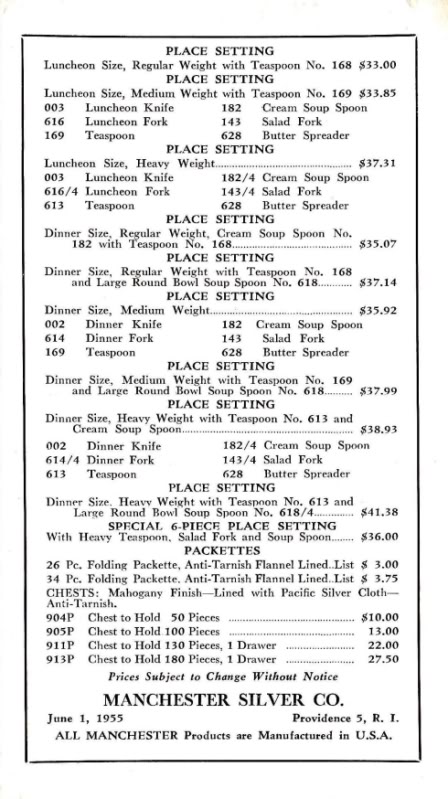
IP: Logged |
chase33
Posts: 362
Registered: Feb 2008
|
 posted 01-24-2010 06:42 PM
posted 01-24-2010 06:42 PM
  
Thanks Taloncrest, I really appreciate your posting. Now I have just one question: what the heck is a "longue fork"? I figured out that longue means long in French but "long fork"? Anyone?Robert IP: Logged |
Dale
Posts: 2132
Registered: Nov 2002
|
 posted 01-24-2010 07:18 PM
posted 01-24-2010 07:18 PM
  
Longue got my attention too. I suspect it is the long handle short blade/tines that is better known as viande or grille. This is most common in silverplate tho there are a few sterling patterns that used the style.IP: Logged |
Dale
Posts: 2132
Registered: Nov 2002
|
 posted 01-24-2010 08:25 PM
posted 01-24-2010 08:25 PM
  
Was Manchester sold thru a network of jewelry stores or was it done some other way? Does anyone here know? From reading the list I suspect that this may have been a party plan or local representative method. Including the Federal Luxery Tax in the price seems odd, and probably illegal. IP: Logged |
taloncrest
Posts: 169
Registered: Jun 2004
|
 posted 01-24-2010 11:40 PM
posted 01-24-2010 11:40 PM
  
I always thought that longue meant the grille style. I've got a small set of Park Avenue, and it is grille or viande. It would also seem that although Park Avenue is not one of the patterns named in the brochure it was still available.I've got a 1954 Becken catalog, and some of the flatware ads state that the retail prices listed include the Federal Tax or Federal Excise Tax, so I'd assume that was standard procedure. I always thought that Manchester was mainly sold in jewelry stores, but I can't prove it. I do know that it was used by the National Rifle Association for prizes in competitions, and I'd assume they got it wholesale. I've only seen the Pilgrim pattern with the NRA monogram, but their publication concerning it implies that other patterns could be used as well. [This message has been edited by taloncrest (edited 01-24-2010).] IP: Logged |
Dale
Posts: 2132
Registered: Nov 2002
|
 posted 01-25-2010 03:24 AM
posted 01-25-2010 03:24 AM
  
There were jewelry stores and then there were other kinds of jewelry stores. The first group were those that followed the rules of the national jewelers associations: they carried upper end tabletop lines, maintained bridal registry procedures and generally were considered to be elegant. Then there were the other kind: frequently these had a speciality, like watch repair or stone setting, had a constantly changing product line. Frequently these jewelers were sort of schlocky outfits, with blaring ads and 'limited quantities'. Some catered to ethnic communities with fine quality products from the old country, we know very little about these. Some were part of a larger store, sort of a rented department. Then there were the ways of selling outside the jewelry trade. The most common one was the local representative. She would come to bridal showers etc and offer lines of flatware, dishes, crystal and linens to the bride to be and her friends. This way of selling was very common in rural areas, frequently the home ec teacher was the seller. This system persisted at least into the early 1980's if not longer. Selling thru fraternal organizations is another way of doing business. I also have encountered indications that some silver firms sold flatware thru furniture stores. I also know that some silver was sold by drugstores and beauty parlors. The ways in which silver moved from the factories to the ultimate consumer is an interesting topic, one on which there does not seem to be a lot of information. IP: Logged |
chase33
Posts: 362
Registered: Feb 2008
|
 posted 01-25-2010 08:19 PM
posted 01-25-2010 08:19 PM
  
Well I was able to confirm with my great-aunt that this set came from a "traditional" jewlery store (in fact it was the only one in the town where my grandparents lived). Don't think I have ever heard of selling silver through a party plan (like tupperware?). BTW, what does MF mean in the description of some of the knives? IP: Logged |
taloncrest
Posts: 169
Registered: Jun 2004
|
 posted 01-25-2010 11:18 PM
posted 01-25-2010 11:18 PM
  
quote:
Originally posted by chase33:
Don't think I have ever heard of selling silver through a party plan (like tupperware?). BTW, what does MF mean in the description of some of the knives?
I've got some of the paperwork for The Royal Crest Society, which is probably one of these party plans. You "joined" the society when you ordered silver and made a down payment. You would pay for your silver in installments directly to the Empire Crafts Corporation. If you got others to enroll and purchase silver, you would get one "Bonus Sterling Certificate" for each person who did so. For every two certificates, you would get a place setting to match your set. Could MF stand for mirror finish? You might be interested to know that Gadroonette was still listed as an active pattern in the 1988 Jeweler's Circular-Keystone Sterling Flatware Pattern Index, as was my Park Avenue. I guess it was still available through the Boardman Company, as according to Rainwater, Manchester was purchased by them in 1985 or 86. She says they in turn were out of business by 1992. IP: Logged |
chase33
Posts: 362
Registered: Feb 2008
|
 posted 01-26-2010 12:11 AM
posted 01-26-2010 12:11 AM
  
MF = Mirror Finish - Well "Duh" on my part! I just knew it was going to be something simple but just couldn't figure it out.When I received this set, I was researching Manchester/Baker and saw that they had been acquired by Boardman. Boardman Silversmiths is still in business and their website lists sterling and pewter gifts, pitchers etc but no flatware. IP: Logged |
dragonflywink
Posts: 993
Registered: Dec 2002
|
 posted 01-26-2010 01:17 PM
posted 01-26-2010 01:17 PM
  
There was quite a bit of door-to-door or home/club plan silver sales, especially in the 1940s-50s. Westmorland, Royal Crest, Fine Arts and Easterling are the companies that immediately pop into my head, they all had just a few innocuous sterling patterns, advertising in ladies magazines, etc. Feel sure that many other manufacturers used similar sales tactics, can remember Oneida's magazine ads in the '60s offering "sample spoons" in sterling, silverplate and stainless.Can't see that there would be any real problem with advertising the total including tax, just another marketing technique. When I tended bar, all the taxes were included in the price (most drinkers dislike having to deal with anything smaller than a quarter). ~Cheryl [This message has been edited by dragonflywink (edited 01-26-2010).] IP: Logged |
Dale
Posts: 2132
Registered: Nov 2002
|
 posted 01-26-2010 07:11 PM
posted 01-26-2010 07:11 PM
  
quote:
Well I was able to confirm with my great-aunt that this set came from a "traditional" jewlery store (in fact it was the only one in the town where my grandparents lived).
The only jewelry store in town is where we enter into the many mysteries of the silver trade. This store had to have a way of financing its inventory. With the major makers (IS, Gorham, Reed & Barton etc) the method was fairly simple. The jeweler bought from the jobber who had right of distribution within a given region. He paid either from funds on hand or got commercial loans to finance the inventory. Which was subject to manufacturers' price control into the mid 60's. The only jeweler in town was in a different situation. He was the sole opening to the local market for the maker. Which meant advantage had shifted from the maker to the local jeweler. This is where the whole system gets creative. One very common selling method for jewelers was to rent inventory. This is how little hole in the wall jewelry stores have trays of very nice rings on display. They pay a flat fee per tray plus a percentage of each sale. Usually the sale is denominated by a penny in the ring slot. The jeweler does not have a high profit margin on sales but has zero investment in actual inventory, so the return on investment looks very tempting. I am sure that jewelers were able to rent silver from smaller, less prestigious makers. This way they had silver on hand for their customers without having to invest. The other way was straight consignment. The jeweler made very little on the sale but again had no investment. I suspect that Manchester was somewhat in this range of the jewelers trade. IP: Logged |
Dale
Posts: 2132
Registered: Nov 2002
|
 posted 01-26-2010 07:23 PM
posted 01-26-2010 07:23 PM
  
Cheryl says: quote:
There was quite a bit of door-to-door or home/club plan silver sales, especially in the 1940s-50s. Westmorland, Royal Crest, Fine Arts and Easterling are the companies that immediately pop into my head...
I would add the silverplate companies Prestige and Nobility. They were in business from the 1930's into the 1960's. And these patterns were sold well into the 1980's. The local representatives were a remakably long lived selling venture. It is easy to forget how rural and small town the US was only 50 or 60 years ago. For major shopping in the areas west of Chicago, women would once a year take the train and spend 3 or 4 days at Marshall Fields, which had special arrangements for the out of town shopper. I have encountered people whose mothers made this journey from eastern Montana and western Nebraska every year for decades. For those who could not make the trip, there were the local sales reps. The party plans for silver, china, crystal, candles and linens. The suit people who measured you every which way, showed you fabric swatches and sent a custom made suit 2 weeks later. There were people who did this for shoes also. This method of selling was very common not that long ago. IP: Logged |
Dale
Posts: 2132
Registered: Nov 2002
|
 posted 01-26-2010 07:32 PM
posted 01-26-2010 07:32 PM
  
Memory being what it is, I just recalled that I know someone who is doing this right now. She is a jeweler who works with a business dresses home party plan. They offer custom business clothing for women. There are the exact measurements for perfect fit. And a huge range of fabrics and colors. And Lisa makes coordinating jewelry for each unique ensemble. She works with glass findings that complement the various fabrics and designs and then customizes each piece to harmonize with the size etc of each individual customer. Curiously, this is price competitive with buying better off the rack clothing. Especially for people who are hard to fit. I have never understood why my custom made belts of high quality cost about what a mediocer mass produced one does. IP: Logged |














